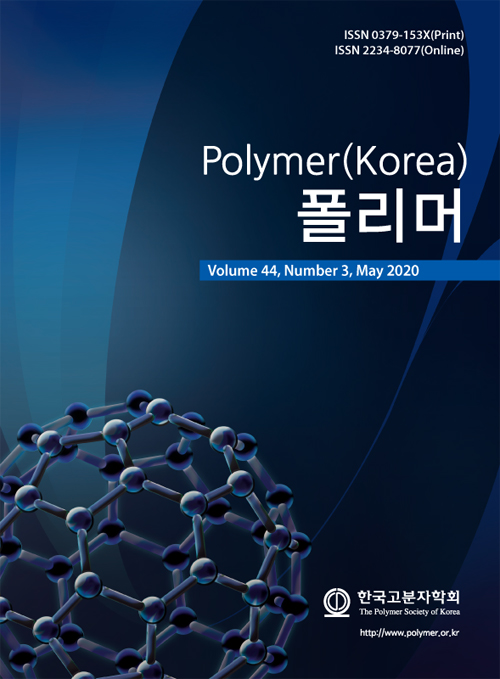- Effect of Reactivity Ratio of Photoreactive Acrylate Monomers on Mechanical Properties of Cured Film
Hyuck Sik Wang, Seung Hyuk Lee, Seok Hyeong Bu, Hong Doo Kim†
 , and Kigook Song†
, and Kigook Song† 
Department of Advanced Materials Engineering for Information and Electronics, Materials Research Center for Information Display, Kyung Hee University, Yongin, Gyeonggi-do 17104, Korea
- 광반응성 아크릴레이트 단량체의 반응성비가 경화필름의 기계적 물성에 미치는 영향
경희대학교 공과대학 정보전자신소재공학과 영상정보소재기술연구센터
When two or more types of
acrylate monomers with a comonomer are cured, the change in the cross-linking
structure of the chain according to the relative reactivity ratio of the
monomers was predicted, and the mechanical properties of the cured film were
described. In the oligomer/diluent/coagulant mixture, the mechanical properties
of the film cured by replacing only butyl acrylate with butyl methacrylate
showed that the ultimate strength increased by more than 5 times and the modulus by 200
times. The phenomenon that the strength of the film was significantly improved
by simply changing the structure of
the diluent, which is an additive that does not directly affect the mechanical
properties of the film, from acrylate to
methacrylate, is a result of curing kinetics of the acrylic reaction and the
cross-linking structure of the chains affected by it.
본 연구에서는 두 종류 이상의 아크릴레이트 단량체를 공단량체로
경화시킬 때, 단량체의 상대적 반응성비에 따른 사슬의 가교구조 변화를 예측하고, 경화된 필름의 기계적 물성 변화를 설명하였다. 올리고머/희석제/응집제로 구성된 아크릴 혼합물에서 희석제 butyl acrylate만 butyl methacrylate로 대체하여
경화한 필름의 기계적 물성이 인장강도는 5배 이상, 그리고 modulus는 200배 이상 증가하는 것을 보여주었다. 필름의 기계적 물성에 직접적으로 큰 영향을 주지 못하는 첨가제인 희석제의 구조를 단순히 아크릴레이트에서 메타크릴레이트로
바꾸어 필름의 강도를 크게 향상시킬 수 있는 현상을 아크릴 반응의 경화 kinetics와 이에 영향을
받은 사슬의 가교구조 변화를 바탕으로 설명하였다..
Keywords: photoreactive acrylate, reactivity ratio, curing kinetics, cured film property
- Polymer(Korea) 폴리머
- Frequency : Bimonthly(odd)
ISSN 0379-153X(Print)
ISSN 2234-8077(Online)
Abbr. Polym. Korea - 2023 Impact Factor : 0.4
- Indexed in SCIE
 This Article
This Article
-
2020; 44(3): 384-390
Published online May 25, 2020
- 10.7317/pk.2020.44.3.384
- Received on Feb 19, 2020
- Revised on Apr 15, 2020
- Accepted on Apr 23, 2020
 Correspondence to
Correspondence to
- Hong Doo Kim, and Kigook Song
-
Department of Advanced Materials Engineering for Information and Electronics, Materials Research Center for Information Display, Kyung Hee University, Yongin, Gyeonggi-do 17104, Korea
- E-mail: hdkim@khu.ac.kr, ksong@khu.ac.kr









 Copyright(c) The Polymer Society of Korea. All right reserved.
Copyright(c) The Polymer Society of Korea. All right reserved.